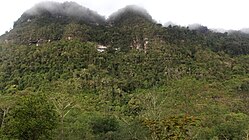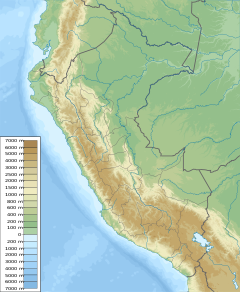| Yumbilla Falls | |
|---|---|
 Bottom section of the waterfalls | |
|
| |
| Location | Amazonas Region, Peru |
| Coordinates | 5°55′11.64″S 77°54′04.32″W / 5.9199000°S 77.9012000°W |
| Type | Tiered |
| Total height | 895.5 m (2,938 ft) |
| Number of drops | 4 |
| World height ranking | 5 |
Yumbilla Falls is a waterfall located near the town of Cuispes, in the northern Peruvian region of Amazonas. It is considered the world's fifth tallest waterfall, becoming internationally known since late 2007 due to a geographical survey conducted by the Geographical Institute of Peru (IGN). [1]
Geography
Yumbilla is 895.5 m (2,938 ft) high, with the top located 2,723.6 m (8,936 ft) above sea level and the base at 1,828.1 m (5,998 ft). [1] The height was measured with the help of laser instruments by a geographical survey of the National Geographic Institute of Peru (IGN) in 2007. [1] [2] This area is part of the Eastern Peruvian Andes, also known as Cordillera Oriental, more precisely, part of a mountain massif called Cerro Panhuayco. [3]
Yumbilla is considered a tiered type waterfall, since it comprises four or five sections or drops. [1] [2] [4] The stream is reported to come from a cave named "Caverna San Francisco". [4]
Climate
The reported mean temperature in the area is 22 °C, with a rainy season from December to April. [4]
Ecology

Flora
The area around the waterfall is covered with montane forest vegetation. Bromeliads, orchids ( Epidendrum secundum, Fernandezia ionanthera, Oncidium scansor), palms (Ceroxylon parvifrons), Andean alders ( Alnus acuminata) and tree ferns ( Cyathea spp.) are commonly found in the area. [4]
Fauna
Animals reported in the area include birds like the Andean cock-of-the-rock and the marvellous spatuletail hummingbird; and mammals like the spectacled bear and the yellow-tailed woolly monkey. [4]
Tourism
From Chachapoyas, capital of the Amazonas region, it takes between 75-85 min. (63 km.) to arrive to the town of Cuispes (the road between the towns of Pedro Ruiz and Cuispes is a dirt road). Public transportation to Pedro Ruiz (buses and collective taxis) is available. From Pedro Ruiz to Cuispes (10 km./30 min.), the main public transportation are mototaxis. [4]
From Cuispes, it takes 1-1.5 hours (6 km.) to reach Yumbilla waterfall by foot or on mule. It is advisable to hire a local guide. [4]
The main activities in the area are hiking and wildlife watching. [4]
There are also other waterfalls nearby, the most remarkable being: Pabellón (400 meters high) and Chinata (580 meters high), both within 4 km in a straight line. [1] [2]
See also
References
- ^ a b c d e "Yumbilla Falls". Wondermondo.
- ^ a b c "Yumbilla, Catarata | World Waterfall Database". www.worldwaterfalldatabase.com. Retrieved 2015-12-17.
- ^ Carta Nacional 1:100000. Vol. Jumbilla (12-h). Instituto Geográfico Nacional (IGN).
- ^ a b c d e f g h "Catarata Yumbilla". Inventario Turístico del Perú (in Spanish). MINCETUR. Retrieved 16 December 2015.
External links
| Yumbilla Falls | |
|---|---|
 Bottom section of the waterfalls | |
|
| |
| Location | Amazonas Region, Peru |
| Coordinates | 5°55′11.64″S 77°54′04.32″W / 5.9199000°S 77.9012000°W |
| Type | Tiered |
| Total height | 895.5 m (2,938 ft) |
| Number of drops | 4 |
| World height ranking | 5 |
Yumbilla Falls is a waterfall located near the town of Cuispes, in the northern Peruvian region of Amazonas. It is considered the world's fifth tallest waterfall, becoming internationally known since late 2007 due to a geographical survey conducted by the Geographical Institute of Peru (IGN). [1]
Geography
Yumbilla is 895.5 m (2,938 ft) high, with the top located 2,723.6 m (8,936 ft) above sea level and the base at 1,828.1 m (5,998 ft). [1] The height was measured with the help of laser instruments by a geographical survey of the National Geographic Institute of Peru (IGN) in 2007. [1] [2] This area is part of the Eastern Peruvian Andes, also known as Cordillera Oriental, more precisely, part of a mountain massif called Cerro Panhuayco. [3]
Yumbilla is considered a tiered type waterfall, since it comprises four or five sections or drops. [1] [2] [4] The stream is reported to come from a cave named "Caverna San Francisco". [4]
Climate
The reported mean temperature in the area is 22 °C, with a rainy season from December to April. [4]
Ecology

Flora
The area around the waterfall is covered with montane forest vegetation. Bromeliads, orchids ( Epidendrum secundum, Fernandezia ionanthera, Oncidium scansor), palms (Ceroxylon parvifrons), Andean alders ( Alnus acuminata) and tree ferns ( Cyathea spp.) are commonly found in the area. [4]
Fauna
Animals reported in the area include birds like the Andean cock-of-the-rock and the marvellous spatuletail hummingbird; and mammals like the spectacled bear and the yellow-tailed woolly monkey. [4]
Tourism
From Chachapoyas, capital of the Amazonas region, it takes between 75-85 min. (63 km.) to arrive to the town of Cuispes (the road between the towns of Pedro Ruiz and Cuispes is a dirt road). Public transportation to Pedro Ruiz (buses and collective taxis) is available. From Pedro Ruiz to Cuispes (10 km./30 min.), the main public transportation are mototaxis. [4]
From Cuispes, it takes 1-1.5 hours (6 km.) to reach Yumbilla waterfall by foot or on mule. It is advisable to hire a local guide. [4]
The main activities in the area are hiking and wildlife watching. [4]
There are also other waterfalls nearby, the most remarkable being: Pabellón (400 meters high) and Chinata (580 meters high), both within 4 km in a straight line. [1] [2]
See also
References
- ^ a b c d e "Yumbilla Falls". Wondermondo.
- ^ a b c "Yumbilla, Catarata | World Waterfall Database". www.worldwaterfalldatabase.com. Retrieved 2015-12-17.
- ^ Carta Nacional 1:100000. Vol. Jumbilla (12-h). Instituto Geográfico Nacional (IGN).
- ^ a b c d e f g h "Catarata Yumbilla". Inventario Turístico del Perú (in Spanish). MINCETUR. Retrieved 16 December 2015.
